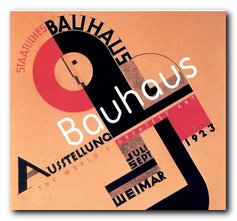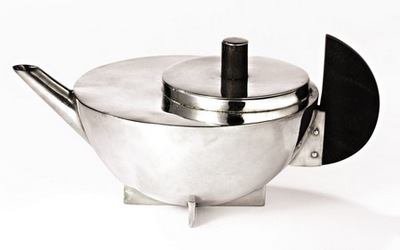modernist design movement
Bauhaus was a design movement which sprang up in Germany in post 1914-1918 as a reaction to the efflorescent curlicues of la Belle Epoque. It emphasised (particularly in theory) rectilinear practicality, function over form, and a political element of art for the masses rather than a privileged few. Most of its designers were of course middle-class artists who were caught up in the revolutionary fervour of the Weimar Republic – but its greatest strength in terms of enduring design is that many of its creations are still in production today. Wallpapers are still in print, vintage retro table lamps are either being reproduced at exorbitant prices, or are trading on eBay for not much less.
 This is an excellent presentation of the work done there – for a number of reasons. First, it shows a wide range of products – from paintings, furniture, and architecture, to photography and household effects. Second, the illustrations are fresh and well researched. There are illustrations here I have never seen before in books on the subject. And third, there is plenty of historical depth and context, including original photos of the Bauhaus studios and the people who taught there.
This is an excellent presentation of the work done there – for a number of reasons. First, it shows a wide range of products – from paintings, furniture, and architecture, to photography and household effects. Second, the illustrations are fresh and well researched. There are illustrations here I have never seen before in books on the subject. And third, there is plenty of historical depth and context, including original photos of the Bauhaus studios and the people who taught there.
The staff list is like a roll call of modernism at its highest – architects Walter Gropius and Mies van der Rohe, designer Herbert Bayer, painters Wassily Kandinsky, Paul Klee, Joseph Albers, and Lionel Feininger, artists El Lizitsky and Moholy-Nagy, plus the constructivists Vladimir Tatlin and Alexander Rodchenko. I was also glad to see that the book included work by the wonderful and much under-rated product designer Marianne Brandt.

The format of the book is simple and effective. Double page spreads are arranged with explanatory text on the left and colour illustrations on the right. Just the right sort of proportion for this type of book. Full details of each item are provided, and there are links to further information in the appendices.
The range of items is quite astonishing. There are buildings (the Bauhaus workshops themselves) designs and photos of completed architectural projects, furniture, wall hangings, paintings, advertising posters, household objects such as electric lamps and tea sets, rugs, children’s toys, and photographs.
However, form and function were not always harmonised as successfully as they might have been. It has to be said that even a design ‘classic’ such as Gerrit Ritvelt’s armchair (1918) looked as modern as modern could be in 1918 – but as design critic Victor Papanek observes
These square abstractions painted in shrill primaries were almost impossible to sit in; they were extremely uncomfortable. Sharp corners ripped clothing, and the entire zany construction bore no relation to the human body
But the overwhelming impression one takes from a collection like this is of design inventiveness working at all levels – from architecture, interior and furniture design, through fabrics and furnishings, down to graphics and typography.
In fact much of today’s architectural design is directly attributable to the influence of the Bauhaus designers. Rectilinear buildings, minimalist interiors, walls made from glass bricks, bentwood furniture, ceiling to floor windows, uncarpeted hard surface floors. Moreover, the spirit of Bauhaus functionality lives on in the products and styles of stores such as Habitat and IKEA.
I got an email only the other day offering copies of the famous Barcelona chair (Mies van der Rohe 1929) for a mere $3000 – only they called it the ‘Madrid’ chair just to cover themselves. So the spirit of the Bauhaus is definitely alive and doing commercially well today thank you very much.
© Roy Johnson 2009
Andrew Kennedy, Bauhaus, London: Flame Tree Publishing, 2005, pp.384, ISBN 184451336X
More on architecture
More on technology
More on design